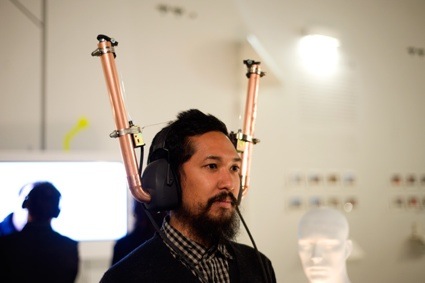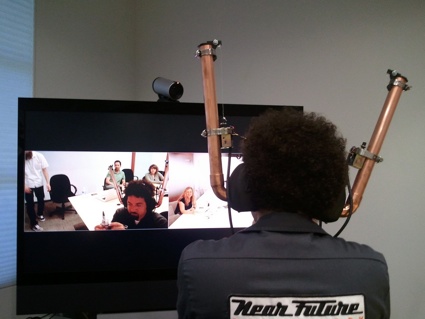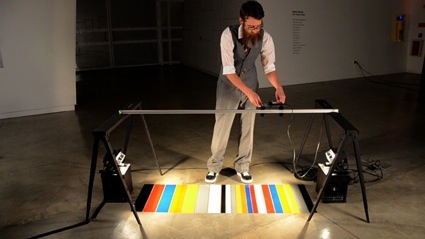 Noisolation Headphones worn during the opening of 4 Hours Solid. Photo by Mikey Tnasuttimonkol & Jeremy Eichenbaum. Model: Mikey Tnasuttimonkol
Noisolation Headphones worn during the opening of 4 Hours Solid. Photo by Mikey Tnasuttimonkol & Jeremy Eichenbaum. Model: Mikey Tnasuttimonkol
This weekend, lucky me!, i’m going to Ghent to see ArtBots Gent, the Robot Talent Show. This international art exhibition for robotic art and art-making robots has been created in 2002 by Douglas Repetto of dorkbot fame. I’ll tell you more about it as soon as i’ve seen the show but in the meantime i wanted to highlight one of the participating works. It might not be tremendously robotic but i found it so intriguing that i contacted Alex Braidwood and had him talk about it.
The Noisolation Headphones attempt to correct an oversight of our body: our ears can’t blink. We can’t block out molesting noise as easily as we can shut off light or disturbing images. In 2004 already, Dr Michael Bull was observing that iPods and other m3 players were used to control their environment, and in particular to shield their users from the sound of the city.
The Noisolation Headphones are a critical investigation that transforms the relationship between a person and the noise in their environment. While worn, exposure to the noise is structured through a sequence designated by a composer which controls the behavior of the sound-prevention valves. The composer also determines what values are adjustable by the listener through the single knob built into the device. The headphones mechanically create a personal listening experience by composing noise from the listener’s environment, rendering it differently familiar.
Hi Alex! I’m very curious by the appearance of the Headphones. Why did you make them so attention-grabbing? What would have been lost if the headphones had looked like any other headphones?
I wanted to make an object that would start a conversation. The goal was to make a sort of visual inquiry that would lead a viewer to develop questions of their own about how we listen and our relationship to our sonic environment. As a media designer, I come from a visual background so it was important that the object itself be visually engaging to inspire a dialog. Formally, I wanted the piece to give an indication of what it was going to do but still leave people curious enough to want to listen for themselves. Through the prototyping process, it became a negotiation between the visual appearance and the acoustic qualities of the materials used. The listening experience needed to take on certain transformative characteristics and, as a result, the final selection of materials and form had to be determined by balancing the visual with the acoustic.
My goal was to make people curious enough about the listening experience to want to wear the piece. I don’t think this would have happened if they looked like just any pair of headphones. I like that when people approach me about them, they tell me they aren’t sure what the experience is going to sound like but by looking at the headphones, they know that they want to find out. It also creates a bit of a spectacle when someone is wearing them which tends to expand the immediate audience and extend the conversation in really great directions. When I, or anyone else for that matter, wear them at an event or out on the street, people will stop and ask about what they are, what do they do, what does it sound like, why did I make them, etc. This aspect of the piece has been a lot fun and it would definitely be missing if it weren’t for the visual nature of the piece.
 Julian Bleecker wears Alex Braidwood’s Noisolation Headphones by Rhys’ Eyes, on Flickr
Julian Bleecker wears Alex Braidwood’s Noisolation Headphones by Rhys’ Eyes, on Flickr
The description of your work states that “The Noisolation Headphones are a critical investigation that transforms the relationship between a person and the noise in their environment.” How is their experience transformed? First technically. Is it just a matter of turning the sound on and off or is the way the wearer manipulate sound more complex?
It’s actually a little more complex than just on and off. Because of the resonant qualities of the copper pipes, the listener is never as isolated as they would be if they were to wear an unmodified pair of hearing protection earmuffs. The characteristics of the noise that surrounds the wearer also impact the experience a great deal because various frequencies resonate through the pipes differently.
Beyond the acoustic qualities of the pipes, there is also the interaction of the valves which open and close based on a combination of pre-composed sequences and user interaction with the selection knob. As the valves open and close, they do manipulate how much noise is allowed to travel to the listener’s ears but they also affect the resonant qualities of the copper pipe. In fact, one unexpected outcome form one of my early prototypes was that even in a relatively noise-free space, there is a still an audible performance for the listener as a result of the sounds from the mechanisms functioning in combination with the “seashell” effect within the headphones. What occurs then for the wearer, no matter what type or level of noise is present, is a listening experience consisting of modified noise from their surroundings, given some form or structure through the compositions assigned to the valves. Issues of noise tend to come down to issues of control of the audio environment. From this perspective, I wanted to explore a way in which control could be something that is developed and then shared with a listener in the form of a composed sequence.
What did the people who tried the headphones on had to say about the way the device had changed the way they experienced the noise that surrounds them in the city?
There are a few different ways that people respond once they have tried on the headphones.
Some people find it calming and have described it as peaceful, tranquil, or almost meditative in nature. They find it interesting that the it is somewhat isolating but in a way that they have not completely lost connection with what is happening around them. Some have even reacted this way to the headphones in places that are incredibly noisy and chaotic.
People also will talk about what they heard and discuss how, when not using the headphones, they hadn’t noticed a particular noise. Because of the materials, certain frequencies resonant differently and this filtration causes their listening focus to shift. I’ve talked with people who really enjoy this and begin discussing what it was within the space they felt made the most interesting tones or textures when heard through the headphones.
There have even been times when other people waiting to wear the piece have started making different kinds of noise for the wearer to hear. I’ve had a couple of events where a half dozen people standing in line waiting their turn are suddenly giving a collective, cacophonous performance of noise for a single listener.
Others have gone a step further and gotten curious about what different things sound like with the headphones on and will begin to explore the space while wearing the device. Seeing the headphones inspire people to take an active roll in the way they hear the city, or any space for that matter, has been really interesting. There’s a great deal of listening that we don’t do when we are audibly-concealed within a headphone+mobile device space. There is space between being completely imposed upon by noise (i.e. the naked ear) and entirely cut-off from the sound around us (i.e. noise cancellation headphones). I think these types of reactions are an indicator that the headphones are operating in this in-between space to some extend but it also provides some indicators of new directions for my research and explorations.
Your work explores the relationships that people have with noise. Can you tell us more about this relationship? For example, do people in cities still pay attention to the noise that surrounds them?
My interest with this relationship between people and the noise surrounding them began when I was attempting to get a handle on what the word “noise” meant in different contexts and to different people. I developed a lot of investigations as well as various probes in order to begin to dig into this and what I found to be of the most interest was that a sound getting labeled as a “noise” in many cases comes down to an issue of control. This led me to look into how people attempt to maintain a level of control over their audio space and as a result, I became interested in the pervasive use of the mobile devices and headphones in public spaces. Which led me to start asking questions about this blocking out and covering up of surrounding noise.
Biologists give a great deal of credit to hearing for our ability to stay alive and evolve over the last couple million years. But over the last couple centuries, we’ve started loosing portions of this that has served very well through time. For example, if you watch an animal like a deer, when it hears a noise that it isn’t expecting, it looks in the direction of the noise and then stands perfectly still in order to assess the risk presented by the source of the noise. As humans living in populated, modern industrial environments, we aren’t really doing this anymore. We have the luxury of assuming things to be relatively safe.
With the increase in “quality” and affordability of noise cancelation technology, one can see noise not only be ignored but go completely unheard no matter what the potential risk might be. We tend not to look in the direction of a noise and asses it for risk any longer. This is true when we are ears-deep in a great album while racing to the train but I also think that this is a good metaphor for what is happening in terms of sound design when introducing new noise into our environment. For example, researchers are starting to find negative effects on hearing and communication from people who, as babies and small children, were highly exposed to white noise machines in order to reduce crying and maintain a sense of calm.
Have you noticed that the way people relate to urban noise in Los Angeles is different from the way they experience noise in other cities?
From what I’ve observed, there are a lot of similarities in places of similar size and with similar resources. For my work, it is more about the fact that it is a shared, populated space more so than a differentiation of one city to another. Part of my personal interest in urban spaces as a type of location for study is that originally, many many years ago now, I am from a very small town in the Midwestern United States. It was, and still is, farm country. There was one traffic light. The crosswalk signs don’t beep or talk. There is no public transportation and people aren’t walking down the three blocks of main street wearing headphones. “Noise” in this environment is a very different thing when compared to a metropolitan area looking to keep its residents safe, moving and informed.
While clicking around your website, i thought that it would be great if your work could be shown more widely in Europe. Do you have any plan to come back to Europe after ArtBots?
Thank you for checking out the rest of my site and I appreciate the nice words. Currently, I do not have any definite plans for showing again in Europe. I am, however, in the process of pursuing a couple opportunities that would bring me back and am very open to any possibilities where my work and interests might be a good fit.
Thanks Alex!
This year’s ArtBots is organised by timelab Gent, in cooperation with ArtBots US, Ugent and Foam. It’s open only over the upcoming weekend in Ghent, Belgium.

